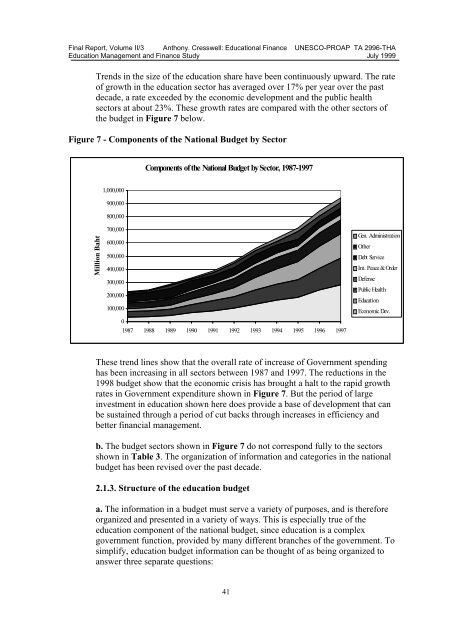Educational Finance in Thailand - UNESCO Bangkok
Educational Finance in Thailand - UNESCO Bangkok
Educational Finance in Thailand - UNESCO Bangkok
Create successful ePaper yourself
Turn your PDF publications into a flip-book with our unique Google optimized e-Paper software.
F<strong>in</strong>al Report, Volume II/3 Anthony. Cresswell: <strong>Educational</strong> <strong>F<strong>in</strong>ance</strong> <strong>UNESCO</strong>-PROAP TA 2996-THA<br />
Education Management and <strong>F<strong>in</strong>ance</strong> Study July 1999<br />
Trends <strong>in</strong> the size of the education share have been cont<strong>in</strong>uously upward. The rate<br />
of growth <strong>in</strong> the education sector has averaged over 17% per year over the past<br />
decade, a rate exceeded by the economic development and the public health<br />
sectors at about 23%. These growth rates are compared with the other sectors of<br />
the budget <strong>in</strong> Figure 7 below.<br />
Figure 7 - Components of the National Budget by Sector<br />
Components of the National Budget by Sector, 1987-1997<br />
1,000,000<br />
900,000<br />
800,000<br />
Million Baht<br />
700,000<br />
600,000<br />
500,000<br />
400,000<br />
300,000<br />
200,000<br />
100,000<br />
0<br />
1987 1988 1989 1990 1991 1992 1993 1994 1995 1996 1997<br />
Gen. Adm<strong>in</strong>istration<br />
Other<br />
Debt Service<br />
Int. Peace & Order<br />
Defense<br />
Public Health<br />
Education<br />
Economic Dev.<br />
These trend l<strong>in</strong>es show that the overall rate of <strong>in</strong>crease of Government spend<strong>in</strong>g<br />
has been <strong>in</strong>creas<strong>in</strong>g <strong>in</strong> all sectors between 1987 and 1997. The reductions <strong>in</strong> the<br />
1998 budget show that the economic crisis has brought a halt to the rapid growth<br />
rates <strong>in</strong> Government expenditure shown <strong>in</strong> Figure 7. But the period of large<br />
<strong>in</strong>vestment <strong>in</strong> education shown here does provide a base of development that can<br />
be susta<strong>in</strong>ed through a period of cut backs through <strong>in</strong>creases <strong>in</strong> efficiency and<br />
better f<strong>in</strong>ancial management.<br />
b. The budget sectors shown <strong>in</strong> Figure 7 do not correspond fully to the sectors<br />
shown <strong>in</strong> Table 3. The organization of <strong>in</strong>formation and categories <strong>in</strong> the national<br />
budget has been revised over the past decade.<br />
2.1.3. Structure of the education budget<br />
a. The <strong>in</strong>formation <strong>in</strong> a budget must serve a variety of purposes, and is therefore<br />
organized and presented <strong>in</strong> a variety of ways. This is especially true of the<br />
education component of the national budget, s<strong>in</strong>ce education is a complex<br />
government function, provided by many different branches of the government. To<br />
simplify, education budget <strong>in</strong>formation can be thought of as be<strong>in</strong>g organized to<br />
answer three separate questions:<br />
41

















